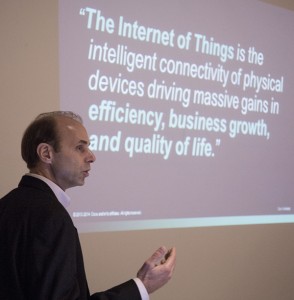
Russ Gyurek of CISCO Systems speaks at an NCDS Tech Talk at UNC-Chapel Hill.
CHAPEL HILL, NC – The Internet of Everything is here, it’s big and growing exponentially, and it promises to transform society even more dramatically than previous disruptive technologies, including the Internet and electricity.
That was one of the key messages at an NCDS Tech Talk Oct. 23 in Sitterson Hall at UNC Chapel Hill. Cosponsored by UNC University Career Services, the talk featured Russ Gyurek, director of innovation in the office of the CTO at CISCO Systems, an NCDS member organization, talking about the next big thing in big data.
What is the Internet of Everything? According to Gyurek, it is the intelligent connectivity of physical devices driving massive gains in efficiency, business growth and quality of life.
The possibilities of the IoE are as broad as its definition: Sensors that inform truckers about real-time road conditions; monitors on offshore drilling rigs that can detect potential problems and help prevent oil spills; devices that track chronic health conditions and give doctors the most up-to-date data on their patients; cars that automatically connect to roadside assistance during emergencies; and production and supply chains that use real-time data to monitor processes, improve efficiency, and cut costs.
Key ingredients that will make the IoE a reality include devices and sensors, networking to connect them to each other and to people, and technologies to manage and glean knowledge from massive amounts of data, including high-performance computing power, data sharing and storage capability, and data analytics applications.
“All that data is useless unless you apply analytics to it,” said Gyurek. “The key is to get some knowledge out of your data to gain insight.”
The IoE already generates massive amounts of data. Smart meters collect about a half terabyte (TB) of data each day, said Gyurek, and a commercial aircraft collects 1 TB of data through various sensors and monitors for every 30 minutes of flight. A large offshore oil field can generate .75 TB of data in a week. All that data, and yet, more than 99 percent of “things” remain unconnected, he said.
The IoE transformation also comes with its share of challenges. Data sets are growing faster than our ability to keep them secure, data policies vary greatly, and, quite simply, connecting a whole world of things and people presents a monumental technical challenge.
Gyurek also highlighted the talent gap in big data fields, noting that in 10 years the need for big data experts will exceed demand by 40 percent. That talent gap also means opportunity for students interested in data-related careers. Specialists who can make sensors more effective and efficient will be in high demand and new jobs we have yet to imagine yet result from worldwide connectivity.
What will the Internet of Everything look like in 2020? Gyurek said 50 billion smart objects should be connected by then. We’re not quite halfway there, but the overall rate of adoption will be five times faster than it was for electricity.
The Internet of Everything talk was the second NCDS Tech Talk at UNC this fall. The first, held Oct. 9, featured Karen Davis, vice president of research computing at RTI International, another NCDS member organization. Davis spoke about RTI’s mission and its efforts to deliver on that mission using data collection, technology applications, and data analysis across multiple disciplines.


